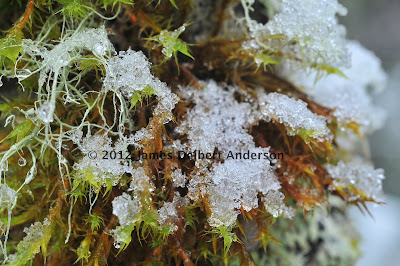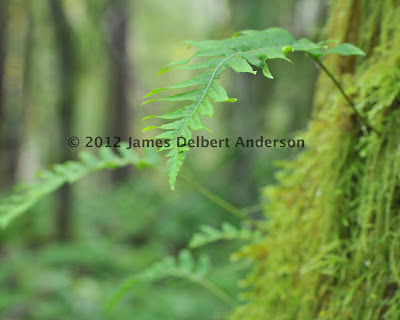The snow level was a bit higher than I had expected - I was thinking 1000-1500 feet, but it was sitting right at about 2000 feet. Thus, I didn't find any snow or ice until almost the top of the mountain. So it was a pretty long slog in exchange for a very small section of trail that actually featured what I was looking for. Still, I took some nice pictures there, and a couple other decent ones in the pleasant, non-snowy sections of the forest.
Honestly, though, it reminds me of why I don't do a ton of hiking in the Issaquah Alps. The second-growth forests of Squak were nice, but not unique or spectacular. The "summit" was also a bit unsatisfying - it consists of a bunch of radio towers, a gravel service road, and some fences. I can honestly say that, after hiking all that way, it was a bit of a let down. I like hikes that are more wilderness-y, have some unique features, or don't require as much work as Squak did for the level of payoff. This is especially true in the spring and summer when I have more options.
Before I found actual snow, I found an interesting ice formation on some hemlock needles. Melt was beginning as I reached this icy section of trail, so I only had a few minutes before it all vanished. The next three pictures are from those few icy minutes; the first is the best, I think.
And from the snowy summit, a picture of some snow that fell on a mossy tree trunk. I like it but am not sure if it's too busy and abstract. Ironically, given all my snow-hysteria, this turned out to be my only post-worthy picture from the truly snowy portions of the trail. Snow is difficult to photograph well; it is so bright that it almost automatically creates contrast problems. It also makes it more difficult to find compelling colors in a scene. Add that to the usual difficulty of isolating compelling subjects in a crowded forest, and you have a challenging situation. For this moss picture, I used an aperture of f/7.1 to make sure I had enough snow in focus. So little of the background behind the trunk is included in the composition that I was able to stop down to f/7.1 without sacrificing background quality.
Finally, one that does not involve snow or ice. In hindsight, I wish I had experimented with moving the camera further to the left, to include more of the sun's brightness. This would have worsened the glare, though; as it was, I had to stand in an awkward position to shield my lens from the sun; even the lens hood didn't cut out the strong glare. Despite all these difficulties, I enjoy the result.
Finally, this one of licorice ferns growing on a trunk (probably big-leaf maple...although I didn't actually take note!). I love how they just grow right on the tree. I used an aperture of f/7.1; in hindsight, I could have used less detail in the background, although I wanted a reasonable amount of detail in the ferns themselves. Oh well, I can always try again - it's not like there's any shortage of epiphytes in the Puget Sound region!





















































